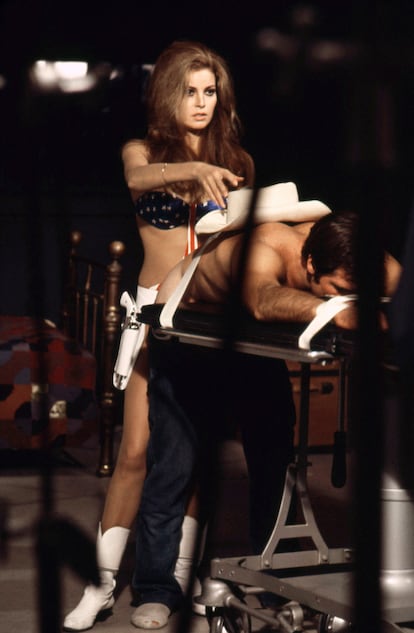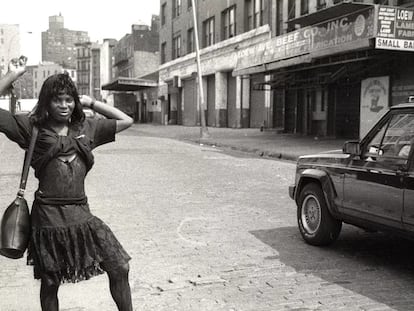Why is strap-on sex still taboo? Fears, myths and the importance of open communication
When even popular TV series such as ‘And Just Like That’ hint at the idea of strap-on sex, it’s a good time to open the door to less conventional sexual practices

In the same way that Sex and the City was able to push thousands of women to buy the “rabbit” vibrator, opening the door to new kinds of female pleasure, pop culture is in charge of gradually introducing new elements into people’s intimate lives. New TV series seem to want viewers in the real world to take notice and dare to try out sex positions that go beyond missionary.
While the first season of And Just Like That was criticized for having practically eliminated sex from the universe of New Yorkers, who, years before, had made it the epicenter of their conversations, the show has now returned to sex and sex jokes. The most striking sexual scene of the current season is one in which Miranda Hobbes’ character tries to put on a leather strap-on to have intimate relations with her partner, Che Diaz (an expert in the field who wants to teach the lawyer how to use it).
By no means has this been the first nod to strap-ons that we’ve seen on screen. Well before this show, the film 50 Shades of Grey already showed viewers unconventional sexuality, including practices such as bondage. In fact, as Eugenia Cames, a sexologist and trainer at Sex Academy Barcelona, points out, some archaeological discoveries have raised the hypothesis that some of the Paleolithic stone dildos could actually be strap-ons, something which has long been present in the history of the art world.
Certainly, the strap-on has been with us for a long time. Back in 1970, Raquel Welch, in the controversial film Myra Breckinridge, demonstrated the act of “pegging” for the first time in mainstream culture… that is, the sexual practice in which a woman penetrates a man anally, while using a prosthesis that is usually attached to the pubis, by means of a waist harness.

Despite the fact that it’s becoming increasingly common to see strap-ons in movies and on television, their use continues to be a taboo subject. “If you like to use strap-ons, and you’re a cis woman and you want to use them with cis men, you will be criticized because you want to take the place of the man [and] subjugate him. Or, simply, you’ll be called a “feminazi.” And, if you want to use a strap-on with another woman, you’ll be criticized for wanting what nature hasn’t given you. As soon as [you produce] something that’s similar to a penis but is always erect and never fails, sparks fly. Machismo is very against the use of strap-ons. If you’re a cis man and you like to use [anal] plugs, you’d better hide it. If you like your partner to give you anal sex with a harness, your friends better not find out, because, all of a sudden, you’ll lose all your male credibility,” explains sexologist Lorena S. Gimeno. “The strap-on is a product designed to put a dildo in front of genitals,” she writes in Feeling and Giving Pleasure with Strap-ons, a guide that’s the result of two years of in-depth research on the use of strap-ons in sexual practices, which was recently presented at the Erotic Museum in Barcelona.
The term “pegging” — coined in 2001 by journalist Dan Savage — is a practice that we’ve seen reflected in comedy and drama, from series such as The Sopranos to Shameless. It was referred to in the famous 1959 novel, Naked Lunch. Despite this, it remains a taboo. “The reason is that it implies a very big role change. She’s suddenly the one who takes the reins, takes the initiative and has the power during sexual intercourse… something traditionally associated with men. It seems that men who desire this practice are considered effeminate or not very masculine. Likewise, the women who perform [the act] seem to not be feminine. In these types of scenarios, everything that’s out of the ordinary sounds like a perversion or deviation from what’s socially established,” says psychologist and sexologist Ana Lombardía. “Actually, whoever’s in command whenever there’s penetration is the person being penetrated, because they’re the one who can decide to stop and who decides on the size of the dildo. Oftentimes, we think that a strap-on is used to replace a penis that doesn’t exist, when this isn’t always the case,” says sexologist Alba Povedano.
Types of strap-ons
The scene in which Miranda Hobbes tries to put on the strap-on is far from being erotic: it’s bathed in comedy and clumsiness, as the character jokes about how difficult it is. Povedano explains that the degree of difficulty varies widely. “There are some that are easier to put on and others that — depending on the straps and how it fits — will be more complicated. The truth is that the moment of putting it on can lower libido a bit if two people are interacting on a sexual level and decide that they want penetration, because they’re forced to stop to put on the harness. [This is a problem] especially if they haven’t prepared [the strap-on] in advance. However, if they know how to put it on and have some practice, it’s not that complex,” she notes.
In Feeling and Giving Pleasure with Strap-ons, there’s a whole chapter dedicated to this. “The ideal harness doesn’t exist, because each person has different needs. Some people will be fine with a strap-on panty with a dildo attached. Others will look for it to be adjustable. Regarding types of strap-ons, I usually divide them between the simple (which look like a panty or a thong), double (with two straps between the legs, to allow for access to the genitals), or those that are also articles of clothing (stockings, corsets, bustiers or loose straps that allow you to stick a dildo to your leg, for example). I dedicate a special category to the strap-ons without a harness, which are dildos designed to be held with the vagina; these are more comfortable and easier to put on, but [they depend] on the strength of your pelvic floor and the intensity that you’re going to give it. The level of difficulty depends on the amount of practice,” says Gimeno.
Fears, myths and the importance of open communication
According to a 2020 survey in Spain published by Statista, 65% of women had used a sex toy at least once in their lives, while the percentage of men was somewhat lower, at 50%. As Ana Lombardía explains, one of the great fears of the use of strap-ons and anal plugs comes from heterosexual men, since this practice is culturally associated with gay men: although sexual orientation really has nothing to do with which part of your body you like to pleasure.
“It’s vital [for any type of couple] to engage in open conversation, because we shouldn’t assume that two lesbian women will like [strap-ons], just as we shouldn’t assume that two gay men will. Communication is vital, regardless of the orientation and type of sexual relationship, although it’s true that, in heterosexual relationships, it’s important that the couple talk about how they feel about anal sex, limits in the bedroom, discussing which dildo is going to be used… the latter, by the way, is chosen by the person who’s going to be penetrated, not by the person wearing the strap-on. It’s important to be clear about this and talk about it beforehand,” Povedano explains.
There are many fears and myths that surround the use of sex toys, as explained by Gimeno. “We find ourselves with the [stereotype] that, if you like it and you’re a woman, you want to be a man… [and], if you like that your wife penetrates you, it’s because you’re gay. In reality, all these myths are the result of [sexist] thinking. As for fears, the first barrier is stigmatization — the fear of what others will say, what they’ll think. We have many preconceived ideas that are difficult to remove. And, once you finally feel comfortable with saying ‘I like to wear strap-ons,’ you don’t know how your sexual partner or partners will react,” the sexologist says. “In practice, the biggest fear is that you can easily hurt your partner with the dildo. That’s why I recommend a lot of communication and patience, dilation, and always having lubricant on hand.”
“Something usually not mentioned about the use of strap-ons is that it can be disappointing. Especially if you think it will give you instant pleasure. The pleasure that’s felt from the use of strap-ons usually comes from mental arousal, or from the toys and vibrators that you add, so that whoever puts it on or receives it feels something more physical. But, as I say in the book, you can teach your brain to feel pleasure with the use of the strap-on,” she notes.
In short, what’s essential when we want to introduce something out of the norm in the bedroom is communication. By establishing some basic conditions, it’s possible to enjoy new experiences in a consensual and safe way.
Sign up for our weekly newsletter to get more English-language news coverage from EL PAÍS USA Edition
Tu suscripción se está usando en otro dispositivo
¿Quieres añadir otro usuario a tu suscripción?
Si continúas leyendo en este dispositivo, no se podrá leer en el otro.
FlechaTu suscripción se está usando en otro dispositivo y solo puedes acceder a EL PAÍS desde un dispositivo a la vez.
Si quieres compartir tu cuenta, cambia tu suscripción a la modalidad Premium, así podrás añadir otro usuario. Cada uno accederá con su propia cuenta de email, lo que os permitirá personalizar vuestra experiencia en EL PAÍS.
¿Tienes una suscripción de empresa? Accede aquí para contratar más cuentas.
En el caso de no saber quién está usando tu cuenta, te recomendamos cambiar tu contraseña aquí.
Si decides continuar compartiendo tu cuenta, este mensaje se mostrará en tu dispositivo y en el de la otra persona que está usando tu cuenta de forma indefinida, afectando a tu experiencia de lectura. Puedes consultar aquí los términos y condiciones de la suscripción digital.
More information
Archived In
Últimas noticias
Most viewed
- Oona Chaplin: ‘I told James Cameron that I was living in a treehouse and starting a permaculture project with a friend’
- Sinaloa Cartel war is taking its toll on Los Chapitos
- Reinhard Genzel, Nobel laureate in physics: ‘One-minute videos will never give you the truth’
- Why the price of coffee has skyrocketed: from Brazilian plantations to specialty coffee houses
- Silver prices are going crazy: This is what’s fueling the rally











































